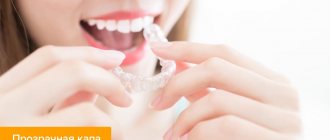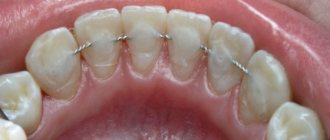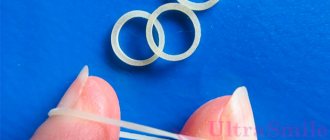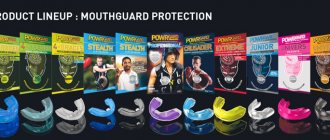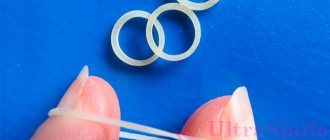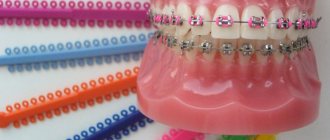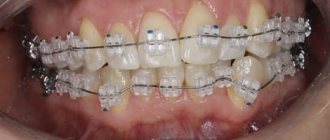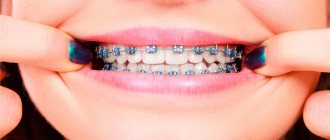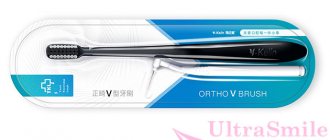Why do you need a dental guard after braces?
Braces correct the bite. This may take several months or even years. When the orthodontic appliance is finally removed, the patient experiences relief. But not everyone knows that after removing braces, teeth can return to their previous incorrect position. This is due to the structural features of the jaw and the physiology of the body, for which it is natural to resist outside interference.
In this article
- Why do you need a dental guard after braces?
- Types of removable mouthguards
- Advantages and disadvantages of removable aligners
- How is an orthodontic mouth guard installed?
- How long do you wear mouthguards after braces?
- How to care for aligners after braces?
- How to wear mouth guards after braces without damaging them?
- Conclusion
In order to prevent repeated curvature of teeth and to maintain the effect of bite correction achieved during orthodontic treatment, the orthodontist prescribes the patient to wear retainers. These are special structures that are worn during the retention period - a time when there is a risk of the tooth returning to its usual position. Retainers hold the teeth in the desired position and allow the ligaments to “get used” to the new bite.
Retainers are removable and non-removable. The latter are wires fixed on the inside of the teeth. A more convenient and popular option is a removable orthodontic mouthguard - after braces, it is worn only at night.
If there is strong bite resistance, the orthodontist may recommend wearing both removable mouth guards after braces and permanent retainers at the same time. In this case, the wire is worn constantly, and the mouth guard is worn only for a certain time at night or during the day.
Night aligners and aligners - what's the difference?
Night aligners also act as a kind of protective structures against pathological involuntary clenching of the jaws during sleep. However, their main function is orthodontic.
Night dental aligners are used for:
- correction of minor bite pathologies;
- strengthening dental units - for example, when using mouth guards with the effect of enamel remineralization. A gel is placed inside the silicone pad, which has a beneficial effect on the enamel;
- consolidation of the result after orthodontic treatment - as a rule, after wearing braces, orthodontists recommend wearing aligners at night for about 6 months.
Types of removable mouthguards
Dental mouthguards differ in material, duration of wear, and production technology:
- Standard models are made according to one sample and do not take into account the specifics of an individual bite. Therefore, they are rarely used after braces. These types of trays are often used for teeth whitening.
- Thermally modeled retainers. Their peculiarity is that they take the unique shape of teeth after heating. Such a mouth guard is first placed in hot water and only then put on the jaw.
- Individual models are the most accurate and convenient. They are made according to the individual anatomical parameters of a particular patient based on a cast of the jaw.
According to the period of wearing, mouthguards are available at night and around the clock. The first ones are worn exclusively at night and are used in “mild” cases of bite correction. They are worn around the clock, removed only during meals and before oral hygiene. These models are suitable for correcting severe malocclusions.
According to the material, mouthguards can be made of silicone and bioplastic. Both options are distinguished by good hypoallergenic properties, transparency and non-invasiveness.
Advantages and disadvantages of removable aligners
Caps have many advantages:
- unlike fixed structures, they can be worn for a limited time;
- using mouthguards after braces is more comfortable, since the jaw “rests” from metal structures;
- Oral care is easier if the retainer can be removed.
The main disadvantage of aligners is that they are a noticeable design that affects appearance, so not everyone is ready to wear such retainers during the day. In addition, the design can cause increased salivation.
Elimination methods
To eliminate the gag reflex, you need to find out the cause, and then take actions aimed at eliminating it. Methods to combat the gag reflex:
- replacing toothpaste with a composition with a different flavor, for example, mint paste with a product with a fruit flavor;
- replacing a brush with a different stiffness and type of bristles;
- When cleaning, do not touch the area of the tongue, when pressed, a reflex appears;
- Do not press the brush against the buccal mucosa.
If the vomiting effect is accompanied by pain and other unpleasant sensations, it is recommended to visit a doctor. There is a possibility that the condition is caused by soft tissue diseases and the need to treat pathology.
In children, this condition is caused by stress or fear of the cleaning procedure. The child needs to be reassured and oral care should be started in the form of an exciting game that will not cause fear.
How is an orthodontic mouth guard installed?
The removable retainer is placed by the orthodontist for the first time; in the future, this can be done by the patient himself. Before the first installation, the doctor prepares the oral cavity for the installation of an orthodontic structure. Checks that the braces system does not damage tooth enamel, evaluates the presence of carious lesions, and covers the teeth with a special protective layer.
A custom-made or thermally modeled mouth guard is placed on the patient's teeth and shown how to remove and put it on independently.
Using a mouthguard to correct an overbite.
The mouthguard is a removable structure made of a special material that does not cause an allergic reaction in the patient. The most commonly used materials are plastic and silicone. The mouth guard is easy to remove and put on the teeth yourself; this does not require any specific conditions or skills, therefore, correcting the bite in this way is often used in children. A mouth guard has a number of advantages compared to other methods of correcting a bite, however, wearing a mouth guard is not suitable for everyone. Mild and minor malocclusions can be corrected with the help of a removable mouth guard, but if we are talking about serious pathologies, mouth guards cannot provide effective treatment. Compared to braces, mouth guards have a significant advantage in terms of aesthetics, since the mouth guard is almost invisible in the mouth, while braces are impossible not to notice. The advantages of treatment with a mouthguard include the fact that the design does not erase the upper layers of the tooth and does not damage soft tissues. Treatment with mouth guards is absolutely safe for the patient.
It should be noted that mouthguards are one of the most comfortable methods of treating dental anomalies. Thanks to mechanical action, the mouthguard corrects the incorrect position of the tooth or teeth, thereby correcting the bite. Mouthguards are made individually, taking into account the specific clinical picture and assigned tasks. By the way, mouth guards are used not only for bite correction, but also as an additional treatment for certain dental problems, as well as for bruxism and enamel color correction. Mouthguards are always prescribed only by a doctor after examination and sanitation of the oral cavity. Based on the results of diagnosing the condition of the dental system, the doctor prescribes one or another type of mouth guard.
How long do you wear mouthguards after braces?
The most common question that patients ask their orthodontist is how long to wear mouth guards after removing braces. For each person, the wearing period is individual and determined by the doctor. For some, a year is enough to fix the bite; for others, it takes more than two years. If you want to roughly calculate how long you need to wear mouthguards after braces, you can use this conditional formula.
Take as a basis the time during which you wore the braces system and double it. This will be the approximate period of wearing the mouthguard. Many people wear it for two to four years. But there are also people whose muscle memory “refuses to remember” the new position of the jaw; the process of fixing the bite is very slow. In this case, you may need to wear a mouth guard for a longer period, sometimes for life.
How to care for aligners after braces?
Oral care when wearing orthodontic appliances should be as thorough as possible to avoid caries and other dental damage. Therefore, when installing retainers, the orthodontist must tell the patient how to properly care for the aligners. Below are basic rules for safe cleaning of orthodontic trays and oral care.
The aligners must be removed twice a day during morning and evening brushing. After removing the structure, you must thoroughly brush your teeth with a brush and paste, clean the interdental spaces with floss, floss or irrigator, and remove plaque from the gums, tongue, and inner surface of the cheeks.
The mouthguard itself is also carefully cleaned with a brush and paste, removing plaque and dirt from it. Once every seven days the structure is treated with a special disinfectant. It is also recommended to use mouthwash more often when wearing removable retainers.
Reasons for the development of the gag reflex
The reasons for the appearance of a gag reflex when caring for the oral cavity are:
- Pregnancy. Women often experience unusual reactions during this period. The taste of the paste can cause severe nausea and make you feel unwell.
- Stress. The body in this condition may not respond correctly to irritants, including brushing teeth, using mouthwash, toothpaste or floss.
- Smell. The care products have a sharp, pronounced aroma. These scents are not suitable for everyone, especially for some specific ingredients.
- Taste. This characteristic of cleaning products is also not suitable for everyone. The only option is an individual choice of composition with an optimal, tolerable taste.
- Mechanical impact. Brushes with different types of bristles can irritate the mucous membrane, causing a gag reflex.
- Fluorine. This element provides protection to the enamel, but it is what causes nausea in many people.
How to wear mouth guards after braces without damaging them?
Mouthguards are made of plastic material, so they can be easily damaged if handled carelessly. In this case, the device will no longer perform its main task - to hold the teeth in the correct position. If it breaks, it cannot be repaired; a new one will have to be made. Therefore, it is important to follow the rules of safe operation.
How to wear a mouthguard correctly:
- To avoid damage, it must be removed before each meal.
- Plastic aligners do not withstand high temperatures well, so you should not drink hot tea, coffee or other drinks with an orthodontic structure in your mouth.
- Between uses, the mouthguards are worn like other personal care products - in special lockable containers. This protects the device from contamination and damage.
- You cannot smoke with a mouth guard in your mouth, because tobacco smoke and tar change the color and structure of the material. The mouth guard becomes cloudy and less flexible.
- The structure is stored at room temperature. Both heat and cold negatively affect its characteristics.

